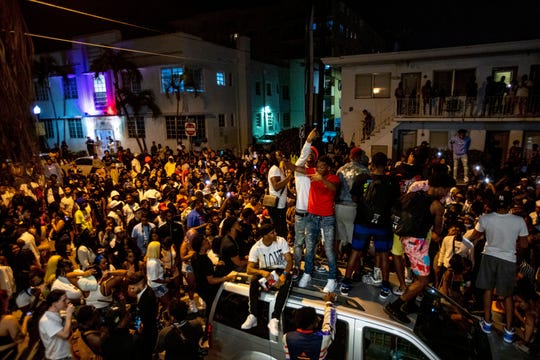
My patient got COVID and died. He thought life was back to normal, but we aren’t there yet.
I was out on the streets of San Francisco last weekend when I noticed something I hadn’t seen in over a year: The hustle and bustle of city life was coming back. People were gathered outside bars and restaurants, crowded and unmasked. There were handshakes and hugs as they moved from one group of friends to the next. It seemed so… normal.
The difference was stark when I returned to work as a hospital physician the next day and witnessed my elderly patient with COVID-19 pass away after days of gasping. A grandfather, he had traveled from the Midwest to visit his family right after receiving his first vaccine shot. But within a week, he developed difficulty breathing.
Like many people across the nation, my patient believed the pandemic to be essentially over and the dangers of returning to normal life to be minimal. But the pandemic is not over. Tens of thousands of new cases are still being diagnosed and there is ominous talk about a “fourth wave.” We are so close to putting COVID-19 to bed, but we should not let up on our precautions just yet.
Trend is positive but danger still lurks
I hate to be the naysayer to those who just want to go out and party like it’s 2019, especially after the horrendous year that we have had. Especially when the overall trend of this virus is positive: Hospitalizations are down, deaths have decreased, and we have reached President Joe Biden’s goal of 100 million vaccinated in 100 days. We are even on track to his very ambitious goal of 200 million vaccinations in 100 days. In my own hospital, our COVID-19 ward is filled with mostly non-COVID-19 patients, with only a smattering affected by the virus or its post-infectious complications.
If everything is going so well, why am I and other public health officials on our pedestal asking people to keep wearing masks and continue social distancing?
Crowds defiantly gather in the street an hour past curfew in Miami Beach, Fla., on March 21, 2021. (Photo: Daniel A. Varela, AP)
First, despite the numbers going down, we are not out of the danger zone yet and the number of new infections is still enormous. Just this week, there were over 60,000 new cases of COVID-19 per day in the United States. To clarify, that’s not per month or even per week, that’s per day. That’s not to say all those people will be at risk for death, or even hospitalization. Fortunately, the majority of those cases will be mild, but the numbers are still staggeringly high and can lead to a prolonging of the pandemic and exposure of the vulnerable.
COVID is still with us: We are ICU nurses. We’re tired. And we need your help again to get through this.
Second, it’s important to remember that we got to where we are today because of these precautions. Until everyone is vaccinated, this is our best protection. There is an alarming trend that some areas of the United States are seeing a rise in COVID-19 cases despite improving vaccine distribution. States in the Northeast, such as Connecticut, are even having increases in hospitalizations. “Right now I’m scared,” Dr. Rochelle Walensky, director of the Centers for Disease and Control and Prevention, said Monday. She said she has a “recurring feeling … of impending doom.”
We’re inviting more unnecessary death
A fourth wave of COVID-19 may be smaller than the previous surges we have seen, but will lead to more unnecessary death nonetheless. As states choose to open up and lift restrictions, we have to realize this puts us at increased risk and act accordingly, by continuing the common sense caution that has gotten us this far.
Finally, it’s wise to remember that full protection from the Pfizer and Moderna vaccines is not achieved until two weeks after the second shot. The same two-week time frame applies after the one-shot Johnson and Johnson, and likely will be similar after the second shot of the upcoming AstraZeneca vaccine. Until those two weeks pass, we are still at risk of contracting severe infection. This is evidenced by the ill-fated and now deceased patient I mentioned at the start. He was under the assumption that partial protection was good enough. Unfortunately, it was not.
Herd immunity: We’ve achieved it for the measles. Will we ever get there on COVID-19?
Being the voice of caution is certainly no fun, and at times, even I know that the public health messaging can sound like a broken record. But it is still the message we need to hear as businesses, restaurants, and bars flip their signs to “Open.”
Look, we are almost through this pandemic. Get vaccinated, wear your mask, and continue to use caution as life slowly creeps back to normal. Eventually, it will be. Just not quite yet.
Dr. Thomas K. Lew is an assistant clinical professor of Medicine at the Stanford University School of Medicine and an attending physician of Hospital Medicine at Stanford Health Care – ValleyCare. All opinions expressed here are his own. Follow him on Twitter @ThomasLewMD
You can read diverse opinions from our Board of Contributors and other writers on the Opinion front page, on Twitter @usatodayopinion and in our daily Opinion newsletter. To respond to a column, submit a comment to [email protected].
Source: Read Full Article
